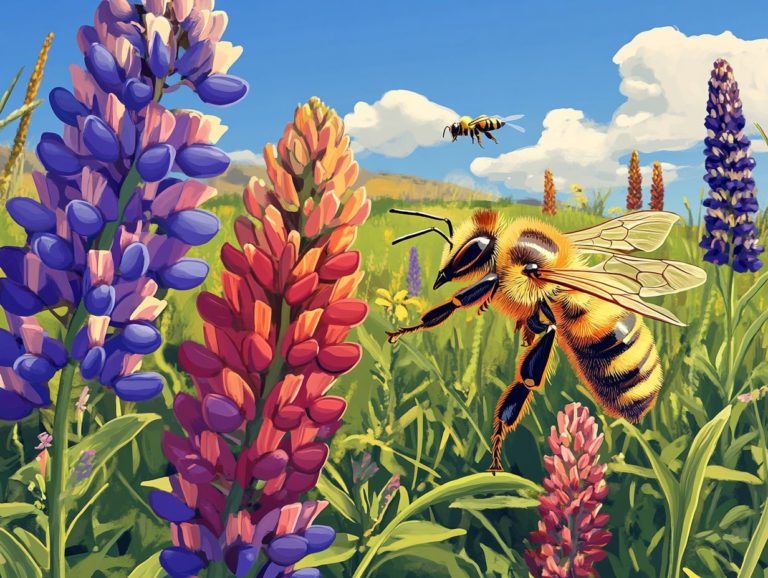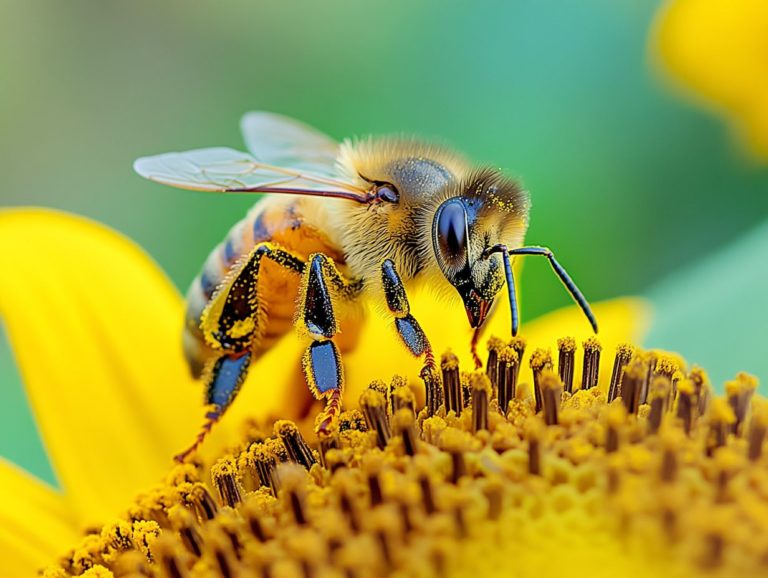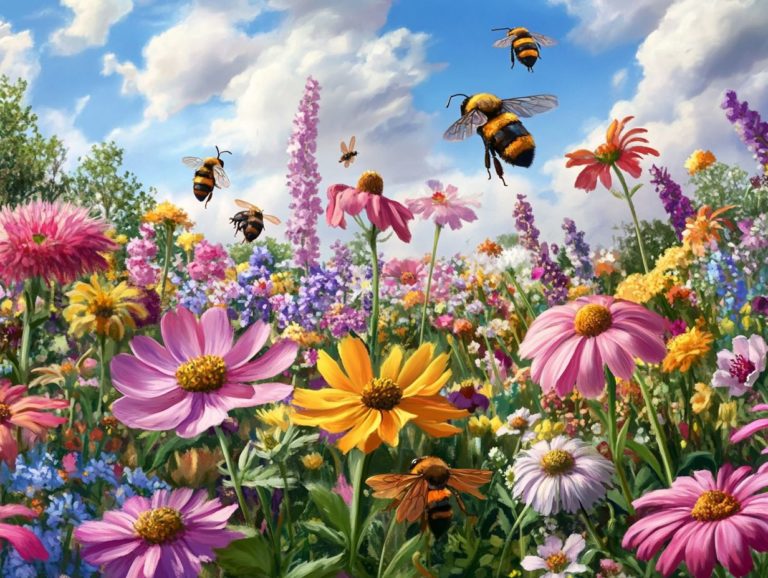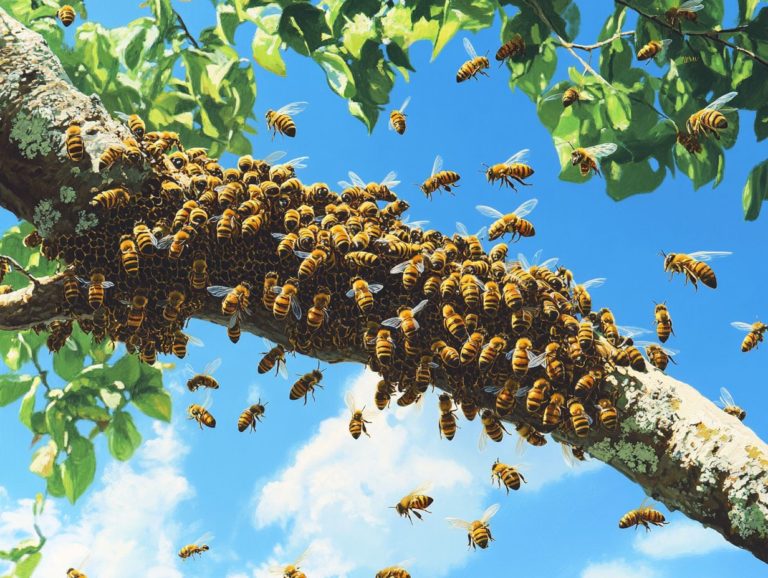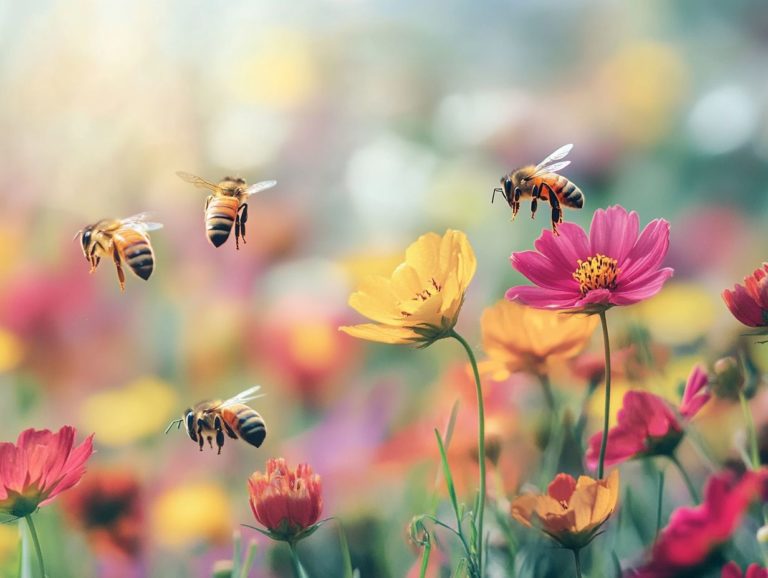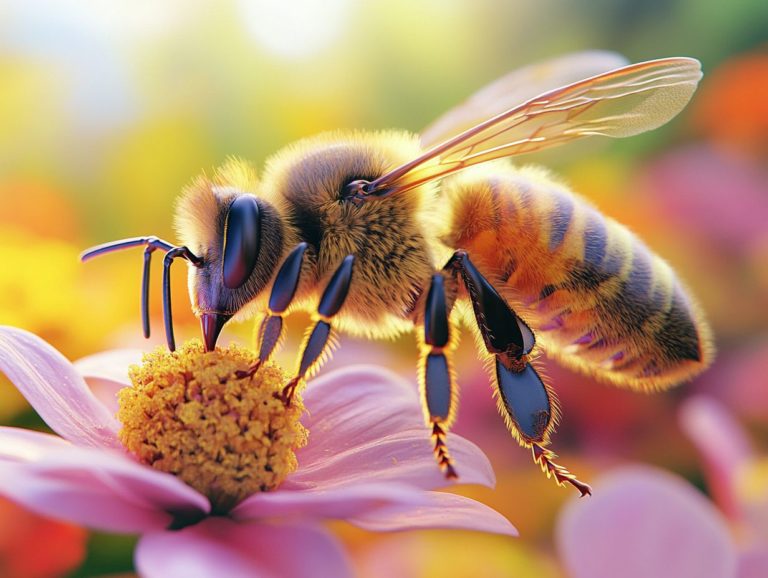How Bee Behavior Affects Honey Production
Honey bees play an essential role in your ecosystem, not only through pollination but also in the production of honey.
Understanding how these remarkable creatures collect nectar and pollen is crucial for appreciating their important contributions. From the vital tasks performed by worker bees to the impact of weather, hive location, and beekeeping practices, every factor influences honey yield.
The health and genetics of bee colonies also shape their productivity significantly, influencing both honey production and raising young bees.
This article delves into these aspects, uncovering the complex behavior of bees, including swarm behavior, and its direct impact on honey production.
Contents
- Key Takeaways:
- How Do Bees Collect Nectar and Pollen?
- How Does the Weather Affect Bee Foraging and Honey Production?
- How Does the Location of the Hive Affect Honey Production?
- How Do Bee Genetics and Health Impact Honey Production?
- Frequently Asked Questions
- How does bee behavior affect honey production?
- What are some examples of bee behavior that can impact honey production?
- How does the weather affect bee behavior and honey production?
- Can bee behavior be managed to increase honey production?
- How does bee behavior affect the quality of honey?
- Can bee behavior have a negative impact on honey production?
Key Takeaways:
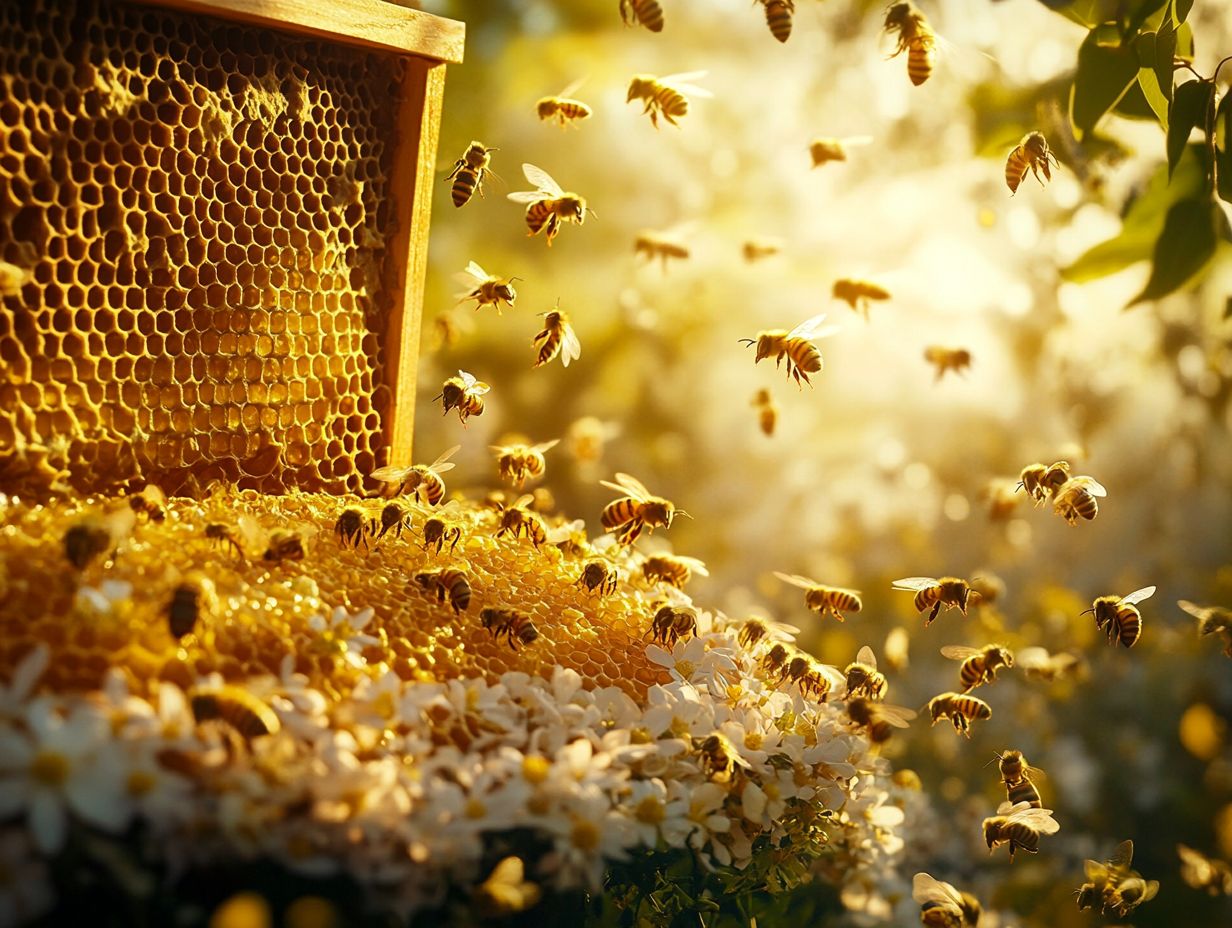
- Bee colonies rely on worker bees to collect nectar and pollen, which are essential for honey production.
- Weather conditions can greatly impact bee foraging and ultimately honey production. Bees can adapt to unfavorable weather and extreme events through climate change adaptation.
- The location of the hive and surrounding environment can affect honey production. Factors such as nearby vegetation, floral resources, and accessibility play a role.
How Do Bees Collect Nectar and Pollen?
Bees, especially honey bees, are critical to the ecosystem, collecting nectar and pollen that are vital for their survival and honey production. This process not only meets their nutritional requirements but also plays an important role in pollinating a wide array of plants, significantly enhancing biodiversity and agricultural productivity.
Worker bees are the foragers of the colony. They embark on journeys to gather crucial resources, showing seasonal behaviors that align with the availability of flowers.
By diving into the intricate methods employed by these industrious pollinators, you can gain valuable insights into effective beekeeping practices and the overall health of honey bee populations, especially during times of nectar scarcity.
What is the Role of Worker Bees in Collecting Nectar and Pollen?
Worker bees stand as the essential agents of nectar and pollen collection, vital for the sustenance of the colony and the production of honey. Their efforts are crucial for brood rearing and maintaining honey stores, especially during winter survival.
These industrious insects engage in a myriad of tasks that significantly contribute to the hive s health and productivity. As the warmer months arrive, you ll find worker bees actively foraging, diligently venturing out to gather nectar from blossoming flowers while also collecting pollen to nourish the developing young bees. This is particularly critical during early spring when bees emerge and begin foraging activities.
Their foraging behavior is not only structured but also remarkably adaptable, responding to the ebb and flow of available resources throughout the seasons. This nectar collection is more than just a means to produce honey, which serves as a crucial food source for the colony; it also fosters the overall vitality of the bee community by supporting the growth and development of new bees. It also helps build honey stores needed for the bees to survive winter.
Together, these hardworking bees form a powerful system that keeps the hive thriving, underscoring their critical role in the intricate world of the practice of beekeeping, including critical tasks at the hive entrance such as guarding and foraging.
Bees possess extraordinary communication skills and navigation methods that are crucial to their colonies’ survival as they search for nectar and pollen, meeting their nutritional requirements.
Through fascinating behaviors like the waggle dance, these insects convey vital information about resource locations, expertly guiding their fellow bees to flourishing floral hotspots. This dance shows other bees where to find food and how far away it is, demonstrating their remarkable capacity to interpret complex environmental signals.
However, factors such as habitat loss, pesticide exposure, and the climate crisis can disrupt these delicate communication systems, ultimately diminishing their foraging efficiency and impacting the overall health of the hive. By understanding how these elements interact, you gain invaluable insights into the challenges faced by these industrious creatures, including honey bee mortality and ecological change.
How Does the Weather Affect Bee Foraging and Honey Production?
Weather holds significant sway over bee foraging behavior and, in turn, honey production. Fluctuations in temperature, humidity, and precipitation directly influence the availability of floral resources, affecting how effectively honey bees can gather nectar and pollen. Climate change exacerbates these fluctuations, impacting beekeeping practices and hive management strategies.
As early spring rolls in and the days begin to warm, bees emerge from their winter slumber to collect essential resources, making the relationship between weather patterns and seasonal behavior crucial for your hive management. This period is vital for brood rearing and ensuring adequate honey stores for future needs.
Moreover, climate change and extreme weather events present challenges that can hinder bees’ foraging efficiency, underscoring the need for you to adopt adaptive strategies in your beekeeping practices, such as apiary relocation and climate change adaptation.
What Weather Conditions are Ideal for Bee Foraging?
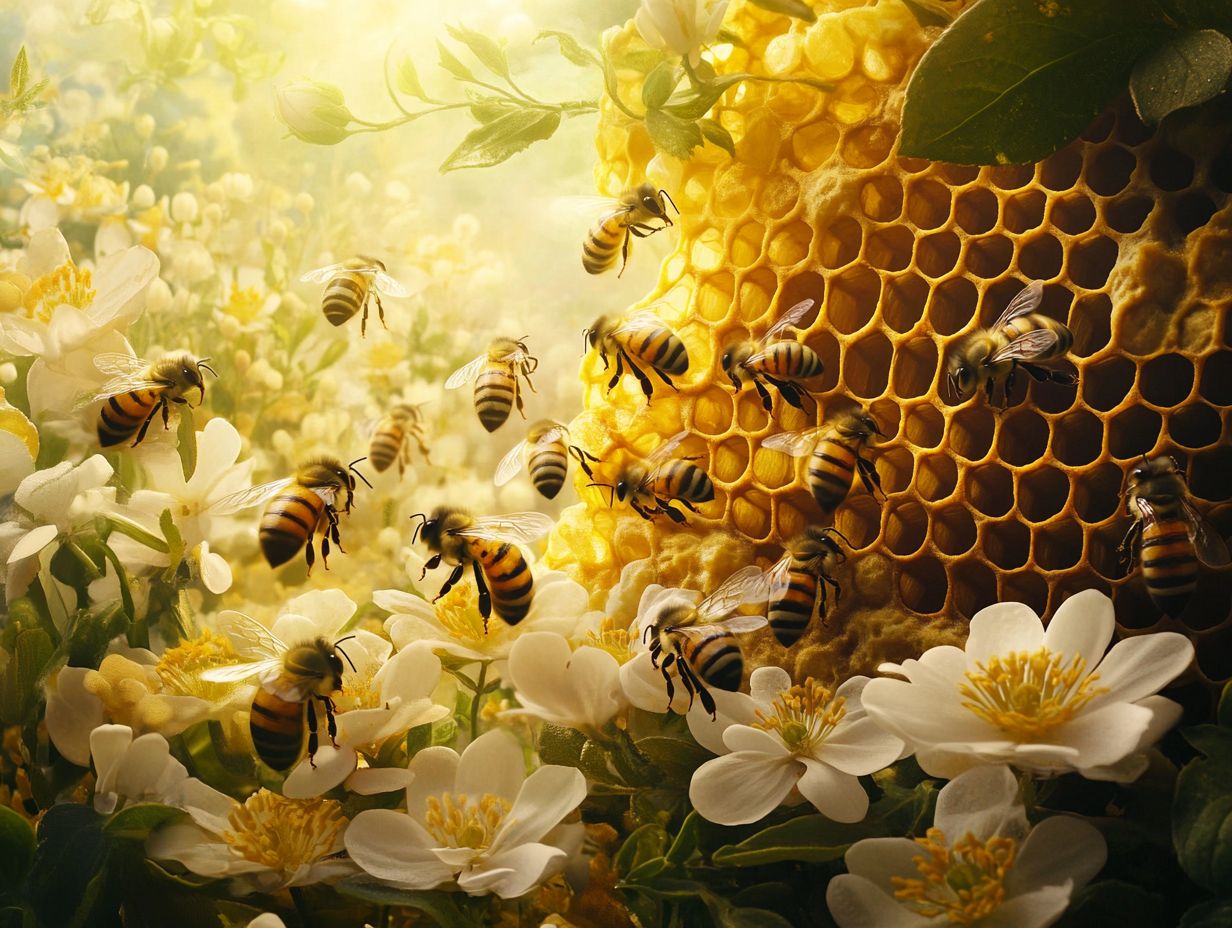
The ideal weather for bee foraging is a harmonious blend of warm temperatures, moderate humidity, and clear skies, creating the perfect backdrop for collecting nectar and pollen.
As temperatures rise between 60 F and 95 F, you ll notice bees become increasingly active, ramping up their foraging efforts. While high humidity can help prevent nectar evaporation, it can also impede the bees’ movement, making them less efficient in their vital tasks.
It s fascinating to consider that honey bees have evolved unique physiological adaptations, including specialized enzymes, enabling them to regulate their body temperature and maintain optimal foraging behaviors, even when the weather isn t cooperating. These adaptations are crucial for their survival and reproductive opportunities.
When you combine stable, warm temperatures with low to moderate humidity, you not only enhance the nectar flow from flowers but also support the bees’ metabolic processes. This synergy plays a critical role in boosting honey production and ensuring the overall health of the colony, contributing to effective honey production strategies.
How Do Bees Adapt to Unfavorable Weather Conditions?
Bees demonstrate a remarkable ability to adapt to unfavorable weather conditions, which is essential for their survival and the continued production of honey. They employ various strategies, such as adjusting their foraging behavior to accommodate changes in temperature and precipitation.
When faced with rain or strong winds, bees may cut back on their foraging trips to conserve energy, relying instead on their stored food reserves. During the colder months, they cluster together within the hive to maintain warmth, effectively creating a microenvironment that protects them from the chill.
As a beekeeper, you can play a vital role in supporting your colonies. Implement practices like providing supplemental feeding during food shortages and ensuring adequate ventilation in hives to help manage humidity. This proactive approach can significantly enhance the resilience of your bee populations against nature’s unpredictable elements, helping them cope with food scarcity and other challenges.
How Does the Location of the Hive Affect Honey Production?
The location of your hive is a critical factor that directly influences honey production, as it determines access to diverse floral resources and impacts bee foraging efficiency. Proximity to nutrient resources and water sources can greatly enhance hive performance.
You should strategically choose an optimal hive location to maximize exposure to abundant nectar and pollen sources, which are essential for developing brood and maintaining colony health.
Consider factors such as proximity to agricultural fields, natural habitats, and the availability of water sources, as these all play a significant role in ensuring that your honey bees can thrive and produce honey effectively. Additionally, take into account the potential impact of pests and diseases on your colonies.
It’s also important for you to take seasonal patterns and environmental changes into account when selecting your apiary sites to truly optimize honey production. Beekeepers perceptions of local conditions can provide valuable insights into site selection.
What Factors Influence the Location of a Hive?
When determining the ideal location for a beehive, you must take into account several key factors, including the availability of floral resources, water sources, and the prevailing environmental conditions.
As a beekeeper, it s essential to look beyond the immediate surroundings and consider the broader ecosystem to ensure your colonies not only survive but thrive. Access to a diverse range of nectar and pollen sources is crucial, as it directly influences the health and productivity of your bees.
Strategic placement can also provide protection for your hives against predators and pests, thereby minimizing the risk of infestations and diseases that could wreak havoc on your colonies. Additionally, understanding the potential impacts of climate change on local flora and weather patterns is vital. Shifting conditions can alter flowering times and the availability of food resources throughout the seasons, making it imperative to stay informed and adaptable in your beekeeping practices. Regular monitoring for Varroa mites and other brood diseases is essential for maintaining colony health.
How Does the Surrounding Environment Affect Honey Production?
The surrounding environment has a profound impact on honey production, as it dictates the availability and diversity of floral resources that honey bees depend on. Nutrient resources in these environments are critical for sustaining robust bee populations.
These factors shape the foraging patterns of bees, directly influencing both the quantity and quality of honey they produce. For example, agricultural practices that lean heavily on monocultures can severely restrict the variety of plants, thereby diminishing the vital nectar sources that bees need. Efficient hive management, including managing bee behavior for better yields, is crucial to mitigating these challenges.
Climate change adds another layer of complexity, altering bloom times and disrupting the delicate synchronization between flowers and their pollinators. Seasonal variations also come into play; unpredictable weather can disrupt plant growth, seasonal behavior, and flowering durations.
Thus, fostering healthy ecosystems is paramount. Robust habitats not only support bee populations but also enhance their foraging activities, ultimately benefiting honey production in a significant way.
How Do Bee Genetics and Health Impact Honey Production?
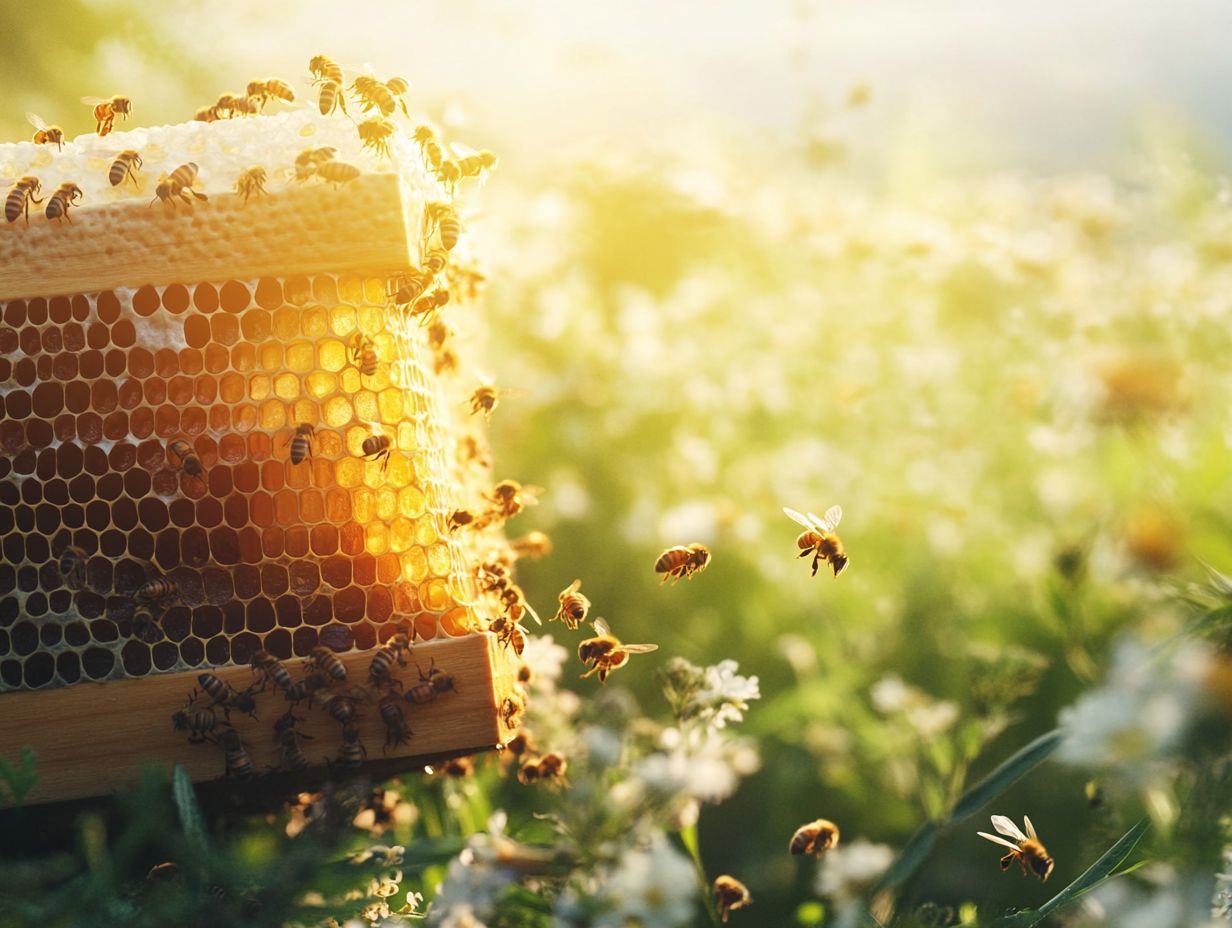
Bee genetics and health are pivotal in shaping the efficiency of honey production within a colony. The genetic makeup of honey bees profoundly influences their foraging behavior, disease resistance, and overall vitality. Understanding honey bees’ physiological aspects helps in better beekeeping practices.
Furthermore, the health of the queen bee significantly impacts the colony’s reproductive opportunities and productivity. Healthy colonies boasting strong genetic traits show superior brood rearing capabilities and an improved ability to respond to environmental changes, enhancing their environmental tolerance.
This resilience allows them to flourish even in the face of challenges like pests and diseases. Grasping the intricate relationship between genetics, health, and honey production is essential for mastering effective hive management and embracing sustainable beekeeping practices.
What Role Do Queen Bees Play in Honey Production?
Queen bees are absolutely vital to honey production, serving as the reproductive heart of the colony and significantly influencing its health and productivity through their pheromones.
These pheromones are essential for coordinating the behavior of worker bees, expertly guiding them in crucial tasks like brood care, foraging for food, and even maintaining the hive s temperature. The queen s continuous presence and her remarkable ability to produce these chemical signals, known as queen pheromone, ensure that the colony stays organized and focused on their shared responsibilities.
As the primary egg-layer, she doesn t just generate new bees to sustain the colony; she also shapes the genetic diversity and resilience of the hive. This direct influence on brood development boosts the colony’s capacity for honey production because a well-structured and healthy bee population is crucial for effective foraging and nectar conversion, impacting seasonal patterns and nutrient resources.
How Do Diseases and Pests Affect Bee Colonies and Honey Production?
Diseases and pests, like Varroa mites, present significant threats to your bee colonies, directly affecting honey production and the overall health of the hive. These invasive parasites cling to adult bees and their brood, undermining their immune systems and hindering brood development, making it hard to meet the nutritional requirements of the colony.
As the strength of your hive wanes, you may find yourself facing increasing challenges in managing your colonies, making effective hive management more crucial than ever. The culmination of these issues often leads to reduced honey yields and honey bee mortality, jeopardizing the sustainability of your beekeeping efforts.
To tackle these adversities head-on, consider adopting proactive strategies such as:
- Regularly monitoring for pests
- Implementing integrated pest management tactics
- Ensuring the genetic diversity of your bee populations through practices like queen rearing and selecting for queen cells
- Practicing supplemental feeding to meet nutritional requirements
Each of these measures can significantly bolster your colony’s resilience and enhance honey production.
Frequently Asked Questions
How does bee behavior affect honey production?
Bee behavior plays a crucial role in honey production as it directly affects the productivity and quality of the honey. Bees have a complex social structure, and their behavior is influenced by various factors such as weather, availability of nectar, and the health of the colony. Extreme weather events and seasonal patterns also play significant roles in influencing bee behavior.
What are some examples of bee behavior that can impact honey production?
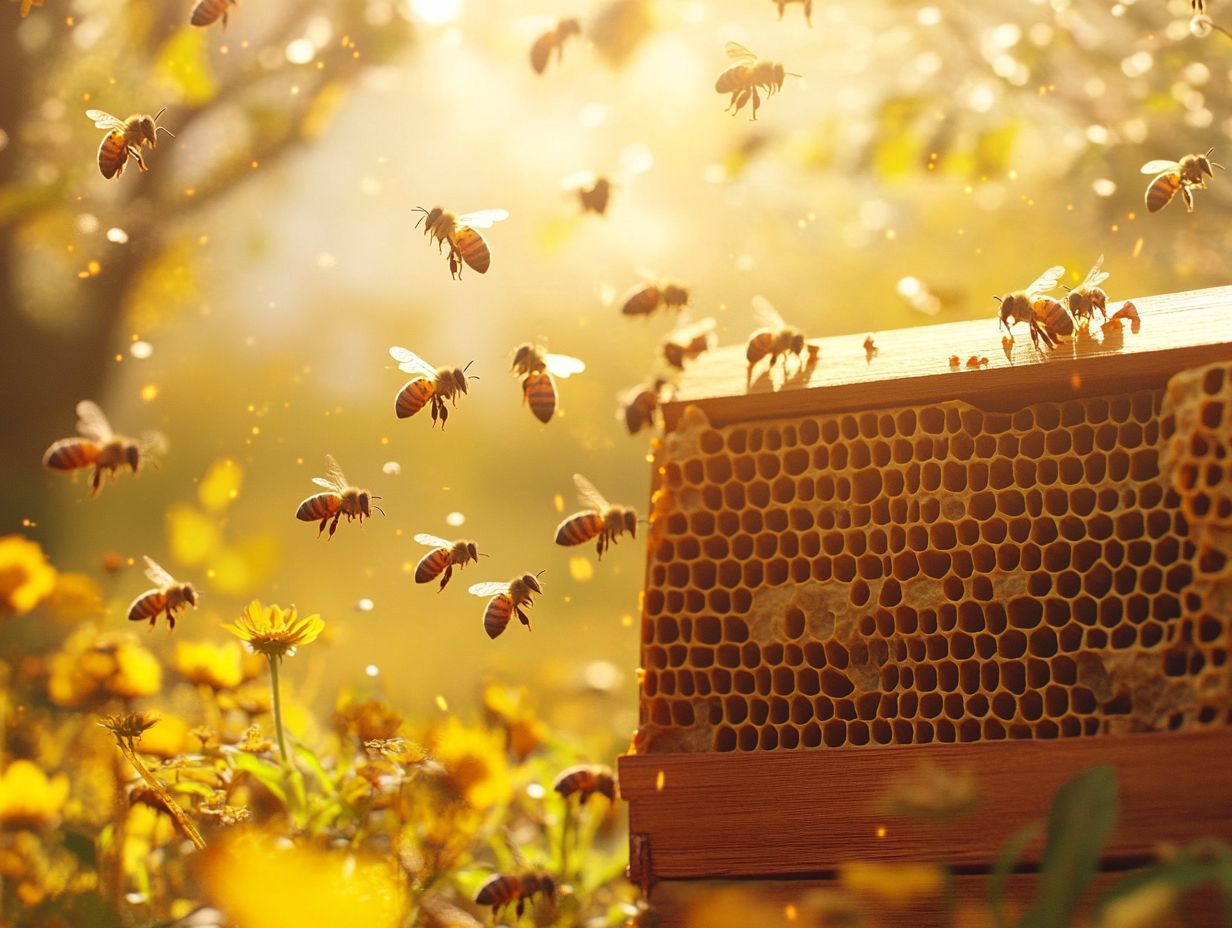
Some examples of bee behavior that can affect honey production include foraging habits, communication methods, and hive organization. Foraging habits determine the amount and type of nectar that bees collect, communication methods can affect the sharing of resources within the colony, and efficient hive organization allows for better storage and processing of honey, especially during periods of nectar dearth.
How does the weather affect bee behavior and honey production?
Weather can greatly influence bee behavior and, in turn, honey production. Bees are sensitive to changes in temperature and humidity, which can affect their foraging and communication habits. Extreme weather conditions, such as heavy rain or drought, can also impact the availability of nectar and pollen, resulting in lower honey production. Climate change adaptation strategies are essential to cope with these weather fluctuations.
Can bee behavior be managed to increase honey production?
Yes, beekeepers can manage bee behavior to optimize honey production. This can be done through hive placement, providing a diverse range of nectar sources, and regularly inspecting and maintaining the health of the colony. Understanding bee behavior and how it is affected by environmental factors is key to managing it for increased honey production, especially in the context of honey production strategies.
How does bee behavior affect the quality of honey?
Bee behavior has a direct impact on the quality of honey. Bees have the ability to selectively collect nectar from different flowers, which can result in honey with unique flavors and nutritional profiles. Their behavior also ensures that the nectar is properly processed and stored in the hive, which contributes to the overall quality of the honey. Floral resources and the presence of developing brood play important roles in this process.
Can bee behavior have a negative impact on honey production?
Yes, certain bee behaviors, such as swarming or absconding, can have a negative impact on honey production. Swarming, where a large portion of the colony leaves with the queen to form a new colony, can decrease the workforce and foraging capabilities of the remaining bees. Absconding, where the entire colony leaves their hive, can result in the loss of an entire honey crop. Swarm behavior and the colony lifecycle are critical factors that need to be managed to avoid such losses.

